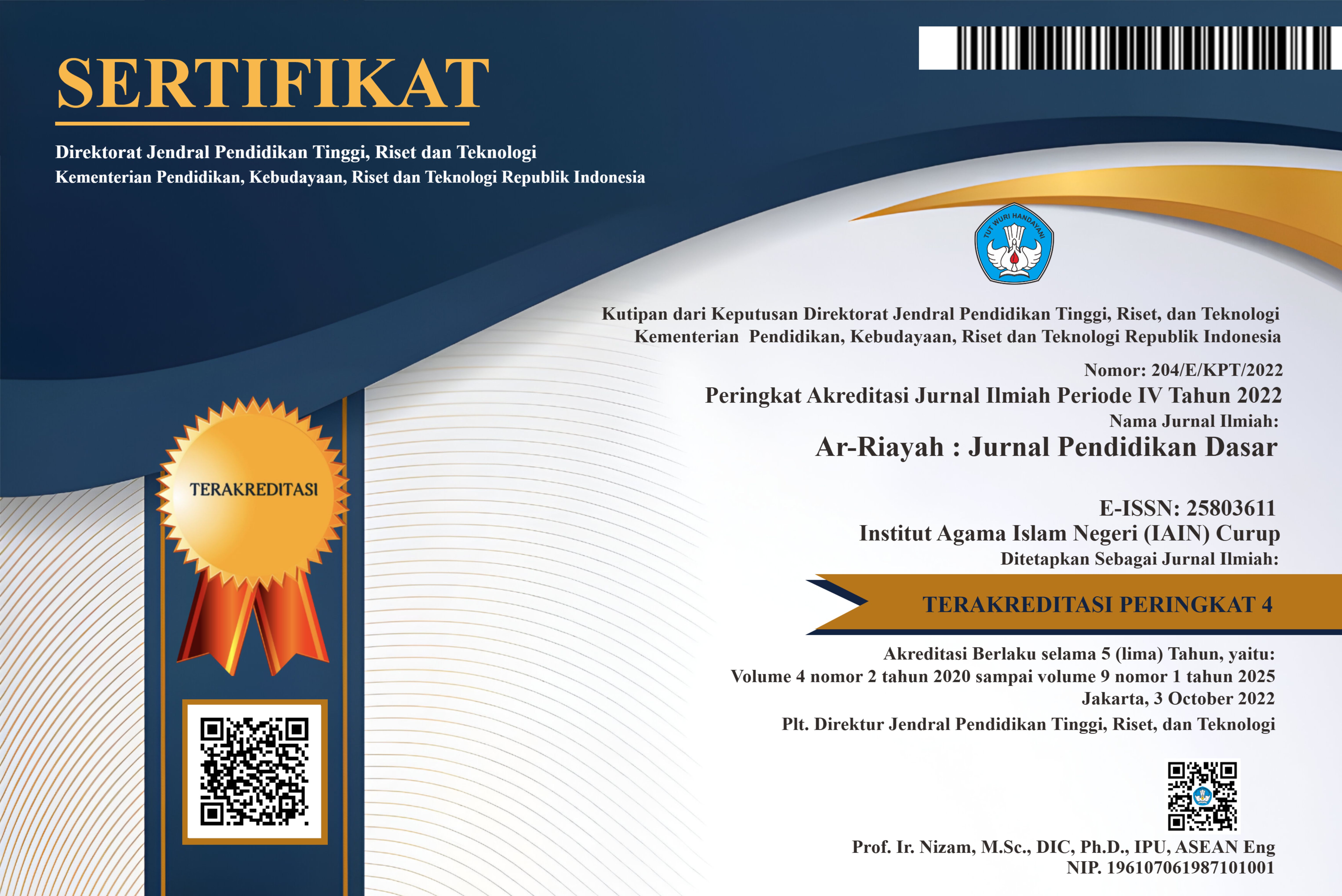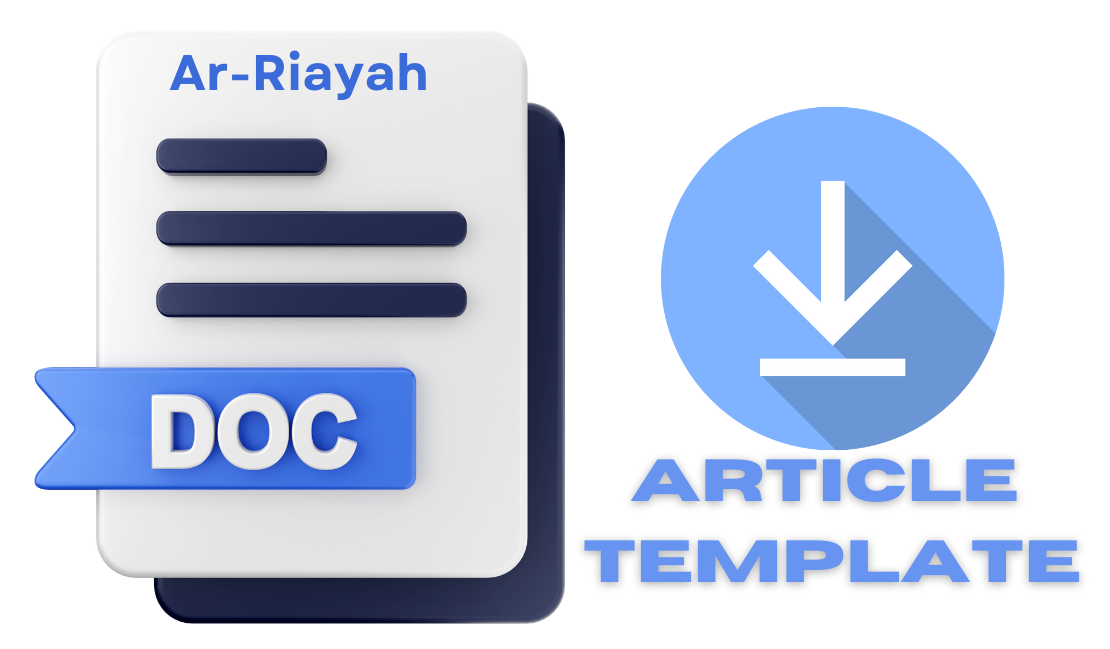Pemanfaatan E-Learning pada Pembelajaran di Prodi PGMI Universitas Islam Negeri Raden Fatah Palembang
DOI:
https://doi.org/10.29240/jpd.v7i1.7669Keywords:
utilization, e-learning, learningAbstract
This study aims to find out how to use e-learning and the obstacles faced by lecturers and students when using e-learning in the learning process in the third semester of the Madrasah Ibtidaiyah Teacher Education (PGMI) Study Program. This study used a qualitative descriptive research method. The data collection tool was a questionnaire with interviews and observation. Data analysis techniques use Miles and Humberman's theory, namely, data reduction, data display, and drawing conclusions. The results showed the use of e-learning in the learning process in third semester of the PGMI study program was very effective. The data showed that almost all courses use e-learning, only two lecturers with the same subject, namely scouts, who do not use e-learning. The data also showed that 71.8% or 135 students said that e-learning was very effective in learning. The constraints faced by lecturers regarding the use of e-learning were that not all of the features in e-learning exist, for example, lecturer attendance was not yet available, so lecturers have to prepare manually outside of the e-learning application, and virtual face-to-face features of e-learning that were tough to accessed, while the students were more on the capacity limit of uploaded videos.
Downloads
References
Agus, Imaludin, and Nur Isra Rasid. ‘Pembelajaran Tatap Muka Terbatas pada Siswa MIN di Era Covid-19: Respon Orang Tua Siswa’. AR-RIAYAH : Jurnal Pendidikan Dasar 6, no. 1 (28 June 2022): 1–16. https://doi.org/10.29240/jpd.v6i1.3868.
Aidah. S. ‘Pemanfaatan E-Learning Sebagai Media Pembelajaran Di STIA Al Gazali Barru (Suatu Studi Terhadap Pemanfaatan Model E-Learning Berbasis Software Claroline)’. Meraja Journal 2, no. 1 (2019): 1–12.
Ajiatmojo, Aan S. ‘Penggunaan E-Learning Pada Proses Pembelajaran Daring’. TEACHING : Jurnal Inovasi Keguruan Dan Ilmu Pendidikan 1, no. 3 (2021): 229–35. https://doi.org/10.51878/teaching.v1i3.525.
Anggraeni, Leni. ‘Pentingnya Model Pembelajaran Pendidikan Kewarganegaraan Berbasis E-Learning Di Era Globalisasi’. Jurnal Ilmiah Pendidikan Pancasila Dan Kewarganegaraan 24, no. 2 (27 June 2016). https://doi.org/10.17977/jppkn.v24i2.5489.
Arianto, Fajar, Lamijan Hadi Susarno, Utari Dewi, and Alfi Fatimatus Safitri. ‘Model Penerimaan Dan Pemanfaatan Teknologi: E-Learning Di Perguruan Tinggi’. Kwangsan: Jurnal Teknologi Pendidikan 8, no. 1 (2020): 110. https://doi.org/10.31800/jtp.kw.v8n1.p110--121.
Aurora, Aviva, and Hansi Effendi. ‘JTEV (JURNAL TEKNIK ELEKTRO DAN VOKASIONAL) Pengaruh Penggunaan Media Pembelajaran E-Learning Terhadap Motivasi Belajar Mahasiswa Di Universitas Negeri Padang’. Universitas Negeri Padang. JTEV 5, no. 2 (2020): 11–16.
Azis, Abdul. ‘PENGGUNAAN E-LEARNING SEBAGAI MEDIA DALAM PROSES BELAJAR BAHASA INGGRIS DI UNIVERSITAS DARWAN ALI SAMPIT’. WIDYA WACANA: JURNAL ILMIAH 15, no. 1 (2020): 56–62.
Bombaes, Ace Navea, and Jeric S. Fuasan Saeed Siyal. ‘Measuring the Impact of E-Learning Adoption: A Case of University of Perpetual Help-Pueblo de Panay, Roxas City, Capiz, Philippines’. The International Journal of E-Learning and Educational Technologies in the Digital Media (IJEETDM) 5, no. 3 (2019): 102–9.
Darmayanti, Tri, Made Yudhi Setiani, and Boedhi Oetojo. ‘E-Learning Pada Pendidikan Jarak Jauh: Konsep Yang Mengubah Metode Pembelajaran Di Perguruan Tinggi Di Indonesia’. Jurnal Pendidikan Terbuka Dan Jarak Jauh 8, no. 2 (8 September 2007): 99–113.
Elyas, Ananda Hadi. ‘Penggunaan Model Pembelajaran E-Learning Dalam Meningkatkan Kualitas Pembelajaran’. Jurnal Warta Edisi Edisi 56, no. April (2018).
Hadisi, La, and Wa Muna. ‘Pengelolaan Teknologi Informasi Dalam Menciptakan Model Inovasi Pembelajaran (E-Learning)’. Jurnal Al-Ta’dib 8, no. 1 (2015): 117–40.
Hanum, Numiek Sulistyo. ‘Keefetifan E-Learning Sebagai Media Pembelajaran (Studi Evaluasi Model Pembelajaran e-Learning SMK Telkom Sandhy Putra Purwokerto)’. Jurnal Pendidikan Vokasi 3, no. 1 (28 February 2013). https://doi.org/10.21831/jpv.v3i1.1584.
Hikmah, Shofaul. ‘Efektifitas E-Learning Madrasah Dalam Pelaksanaan Pembelajaran Jarak Jauh Masa Pandemi Coronavirus Disease 2019 (Covid-19) Di MIN 1 Rembang’. Jurnal Edutrained : Jurnal Pendidikan Dan Pelatihan 4, no. 2 (2020): 73–85. https://doi.org/10.37730/edutrained.v4i2.81.
Hulukati, Evi, Novianita Achmad, and Muhammad Afdal Bau. ‘Deskripsi Penggunaan Media E-Learning Dalam Pembelajaran Matematika Di Masa Pandemi Covid-19’. Jambura Journal of Mathematics Education 2, no. 1 (2021): 21–27. https://doi.org/10.34312/jmathedu.v2i1.10061.
Husnussaadah. ‘Strategi Pembelajaran E-Learning Di Era Digitalisasi’. IQRA : Jurnal Pendidikan Agama Islam 1, no. 1 (2021): 10–16. https://doi.org/10.26618/iqra.
Kholipah, Nur, Deasy Arisanty, and Karunia Puji Hastuti. ‘Efektivitas Penggunaan E-Learning Dalam Pembelajaran Daring Selama Masa Pandemi COVID-19’. JPG (Jurnal Pendidikan Geografi) 7, no. 2 (2021): 24–33. https://doi.org/10.20527/jpg.v7i2.10206.
Mualla, Karim. ‘Standardizing Adaptive Learning through Cloud Computing: A Decision-Making Framework for Higher Education’. The International Journal of E-Learning and Educational Technologies in the Digital Media (IJEETDM) 5, no. 4 (2019): 122–33.
Mujib, Kholil, and Muna Erawati. ‘Pengaruh Media Pembelajaran Google Classroom Terintegrasi dengan Kahoot Terhadap Minat dan Hasil Belajar Siswa Mata Pelajaran IPA Materi Siklus Air’. AR-RIAYAH : Jurnal Pendidikan Dasar 6, no. 1 (28 June 2022): 35–48. https://doi.org/10.29240/jpd.v6i1.4348.
Mustakim, Sagita, and Khairunnisa. ‘JSH , Vol. 2 No. 2, Desember 2019’. Jurnal Sosial Humaniora 2, no. 2 (2019): 1–7.
Ni Kd Mega Ratnawati, IDG Budi Utama, I Pt Mas Dewantara. ‘Pemanfaatan E-Learning Pada Mata Pelajaran Bahasa Indonesia’. Jurnal Pendidikan Bahasa Dan Sastra Indonesia Undiksha 9, no. 1 (2019): 46–56.
Ratnawati, Siti Rohmaturrosyidah, and Wilis Werdiningsih. ‘Pemanfaatan E-Learning Sebagai Inovasi Media Pembelajaran PAI Di Era Revolusi Industri 4.0’. Belajea; Jurnal Pendidikan Islam 5, no. 2 (2020): 199. https://doi.org/10.29240/belajea.v5i2.1429.
Rofiah, Bayin Natul, and Moh. Danang Bahtiar. ‘Analisis Penggunaan E-Learning, Intensitas Latihan Soal, Dan Motivasi Belajar Terhadap Hasil Belajar Siswa’. Edukatif : Jurnal Ilmu Pendidikan 4, no. 2 (2022): 2143–55. https://doi.org/10.31004/edukatif.v4i2.2453.
Shodiq, Imam Ja’far, and Husniyatus Salamah Zainiyati. ‘Pemanfaatan Media Pembelajaran E-Learning Menggunakan Whastsapp Sebagai Solusi Ditengah Penyebaran Covid-19 Di Mi Nurulhuda Jelu’. Al-Insyiroh: Jurnal Studi Keislaman 6, no. 2 (2020): 144–59. https://doi.org/10.35309/alinsyiroh.v6i2.3946.
Silahuddin, Silahuddin. ‘Penerapan E-Learning Dalam Inovasi Pendidikan’. CIRCUIT: Jurnal Ilmiah Pendidikan Teknik Elektro 1, no. 1 (2 September 2015). https://doi.org/10.22373/crc.v1i1.310.
Suharyanto, and adele B. L. Mailangkay. ‘Penerapan E-Learning Sebagai Alat Bantu Mengajar Dalam Dunia Pendidikan’. Jurnal Ilmiah Widya 3 (2016): 17–21. https://doi.org/10.1016/j.neubiorev.2016.02.001.
Sukarno, Muhammad. ‘Dinamika Perkembangan E-Learning Dan Tantangannya Dalam Media Pembelajaran Mohamad’. Kontinu: Jurnal Penelitian Didaktik Matematika 4, no. 2 (2020): 110–24.
Ucu, Nurlinda L., Sary D.E. Paturusi, and Sherwin R.U.A. Sompie. ‘Analisa Pemanfaatan E-Learning Untuk Proses Pembelajaran’. Jurnal Teknik Informatika 13, no. 1 (2018). https://doi.org/10.35793/jti.13.1.2018.20196.
Widianto, Edi. ‘Pemanfaatan Media Pembelajaran Berbasis Teknologi Informasi’. Journal of Education and Teaching 2, no. 2 (2021): 213. https://doi.org/10.24014/jete.v2i2.11707.
Wijaya, Reni, Mustika Lukman, and Dorris Yadewani. ‘Dampak Pandemi Covid19 Terhadap Pemanfaatan E Learning’. Jurnal Dimensi 9, no. 2 (2020): 307–22. https://doi.org/10.33373/dms.v9i2.2543.
Yuliana, Yeni. ‘Analisis Keefektivitasan Pemanfaatan E-Learning Sebagai Media Pembelajaran Pendidikan Agama Islam Pada Masa Pandemi Corona (Covid-19)’. SALAM: Jurnal Sosial Dan Budaya Syar-i 7, no. 10 (2020): 875–94. https://doi.org/10.15408/sjsbs.v7i10.17371.
Yustanti, Ike, and Dian Novita. ‘Pemanfaatan E-Learning Bagi Para Pendidik Di Era Digital 4.0 Utilization of E-Learning for Educators in Digital Era 4.0’, Prosiding Seminar Nasional Program Pascasarjana Universitas Pgri Palembang’. Jurnal Univ PGRI Palembang 12, no. 1 (2019): 338–46.
Downloads
Published
How to Cite
Issue
Section
Citation Check
License
Authors who publish with Ar-Riayah: Jurnal Pendidikan Dasar agree to the following terms:
Authors retain copyright and grant the journal right of first publication with the work simultaneously licensed under a Creative Commons Attribution-NonCommercial-ShareAlike 4.0 International License (CC BY-NC-SA 4.0) that allows others to share the work with an acknowledgment of the work's authorship and initial publication in this journal.
Authors are able to enter into separate, additional contractual arrangements for the non-exclusive distribution of the journal's published version of the work (e.g., post it to an institutional repository or publish it in a book), with an acknowledgment of its initial publication in this journal.
- Authors are permitted and encouraged to post their work online (e.g., in institutional repositories or on their website) prior to and during the submission process, as it can lead to productive exchanges, as well as earlier and greater citation of published work (See The Effect of Open Access).










